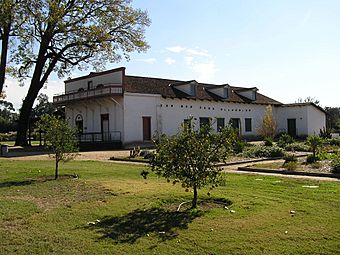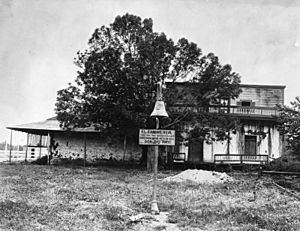Pío Pico State Historic Park facts for kids
Quick facts for kids |
|
|
Pío Pico Casa
|
|

The adobe and grounds after the 2000–2003 restoration
|
|
| Location | 6003 Pioneer Blvd Whittier, California |
|---|---|
| NRHP reference No. | 73000408 |
| Added to NRHP | June 19, 1973 |
Pío Pico State Historic Park is a special place in Whittier, California. It's the last home of Pío Pico, a very important person in California's past. He was the final governor of Alta California when it was under Mexican rule.
His home is known as El Ranchito, the Pío Pico Adobe, or the Pío Pico Mansion. The park is located at 6003 Pioneer Blvd. It's recognized as California Historical Landmark No. 127. This landmark is called "Casa de Governor Pío Pico." The park includes the old adobe house and about three acres of land around it.
Contents
The Story of Pío Pico's Home
Building El Ranchito
After the Mexican–American War ended in 1848, Pío Pico started buying land. He acquired about 10,000 acres of Rancho Paso de Bartolo. In 1853, he built his first home on this land.
Challenges and Changes to the House
The home faced tough times. In 1867, a big flood damaged it. This flood also changed the path of the San Gabriel River to where it is today. Another flood in 1882 almost completely destroyed the house.
After these floods, the house was rebuilt into its current look. It combined traditional Californio design with newer American-style features.
Losing His Home
Sadly, Pío Pico lost his home in 1892. He had taken what he thought was a loan from an American lawyer named Bernard Cohn in 1883. Pico could not read or write English. He had actually signed over the deed to his property. The courts sided with Cohn, and Pico was forced to leave his home. He passed away two years later, living with his daughter and without much money.
Saving Pío Pico's Historic Home
Becoming a Historic Monument
By 1898, the City of Whittier began buying parts of the property. They wanted to build a water pumping station. But local citizens in Whittier wanted to save Pico's home.
In 1907, a group led by Harriet Williams Russell Strong succeeded. They helped make the site a historic monument. Strong, who had known Pico for many years, bought the property herself. She had it restored in 1909.
State Park Status and Restoration
The property was given to the State of California in 1917. In 1927, it became one of California's first State Historic Parks. The state did more renovations in 1944.
The adobe house was badly damaged by the 1987 Whittier Narrows earthquake. This forced the park to close. While money was being raised for repairs, the 1994 Northridge earthquake caused even more damage.
Finally, in 1996, voters in Los Angeles County approved a plan. This plan set aside $2.5 million to restore the park. Work on the house began in 2000. The historic gardens were restored in 2002. The park proudly reopened on September 20, 2003.
At the reopening, there was a special event. People re-enacted the Battle of Rio San Gabriel. This battle happened nearby during the Mexican–American War.
Keeping the Park Open
Efforts to Prevent Closure
In 2008, the park was one of 48 California state parks that might have closed. This was part of a plan by Governor Arnold Schwarzenegger to save money. Luckily, none of those closures happened then.
However, in 2011, Governor Jerry Brown again considered closing about seventy state parks, including Pío Pico State Historic Park. To keep it open, a group called the Friends of Pio Pico worked with the City of Whittier. Together, they raised $80,000. Their efforts helped save the park from closing.
California Historical Landmark Marker
What the Marker Says
A special marker at the site tells its story. California Historical Landmark Marker No. 127 reads:
- NO. 127 CASA DE GOVERNOR PÍO PICO - After the Mexican War, Pío Pico, the last Mexican governor, bought 9,000 acres of Rancho Paso de Bartolo. He built an adobe home here, but floods in 1883-1884 destroyed it. His second adobe house, now called Pío Pico Mansion, shows a mix of Mexican and American styles. While living here, the former Governor was active in developing American California.


